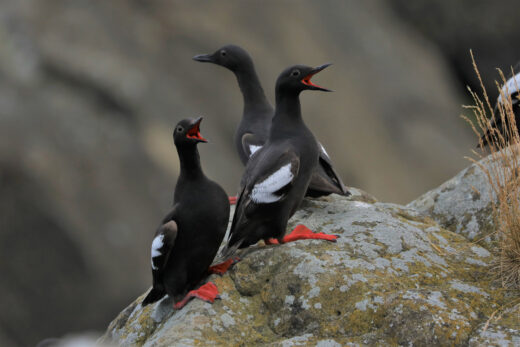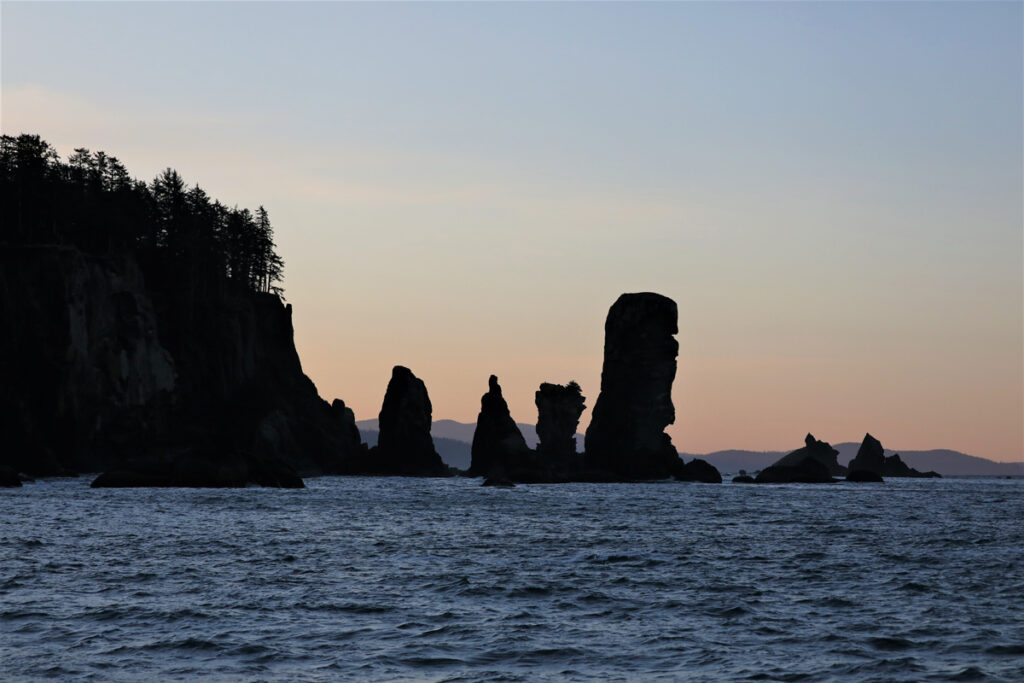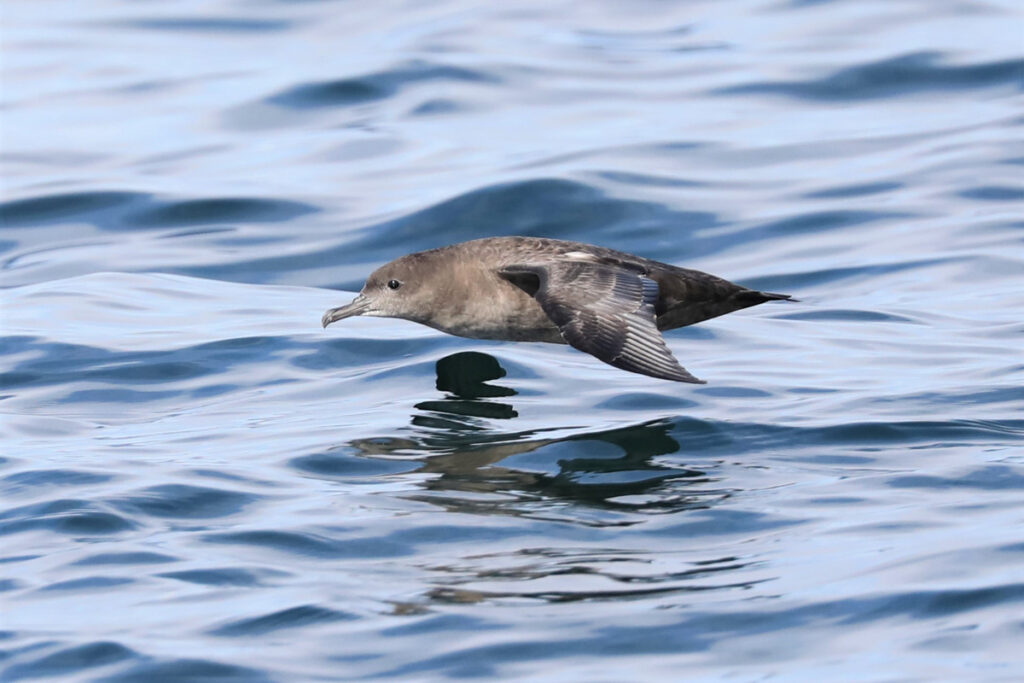Marine

The marine environment of the Pacific Northwest is diverse, ranging from shallow estuarine conditions to deep, blue, offshore waters. Pacific Northwest waters are contained in both the California Current Large Marine Ecosystem and the Salish Sea. Our marine environments provide critical habitats to a variety of breeding and non-breeding birds during critical life stages, including breeding, wintering, migrating, molting, as well as spring staging.
The Waters
The California Current System is one of 64 Large Marine Ecosystems (LMEs) worldwide. LMEs are regions of the world’s oceans that encompass coastal areas from river basins and estuaries to the seaward boundaries of continental shelves and the outer margins of the major ocean current systems. They can be hundreds of thousands of square kilometers in area and are characterized by distinct bathymetry, hydrography, productivity, and interdependent populations of birds, fish, invertebrates, and plankton.
The California Current LME is part of the great North Pacific gyre that spans nearly 3,000 km from southern British Columbia to Baja California. In this system, plumes of cold, nutrient-rich water typically appear annually along the coast in the spring and summer, as surface water is pushed south by seasonal winds and deflected offshore. This results in a highly productive system that supports coastal food webs and an impressive variety of seabirds in all stages of life. The productivity of this system is highly variable in both time and space.

Pigeon guillemots, members of the alcid family, on Destruction Island. Photo Credit: Scott F. Pearson
The Salish Sea–which refers to the Strait of Juan de Fuca, Puget Sound, and Strait of Georgia collectively–has unique coastal environments that include deep fjord-like habitats, estuaries, and nearshore rocks and islands. Unlike the coast, the Salish Sea is a non-upwelling system and is largely influenced by tidal currents and freshwater inputs from coastal rivers like the Fraser and the Skagit. At least 70 species of birds are highly dependent upon the Salish Sea’s marine environment for survival.
The term “marine birds” or “seabirds” includes tubenoses (albatrosses, shearwaters, fulmars, and storm petrels), alcids (puffins, murrelets, and auklets), and most gull species. Some definitions also include the seaducks (e.g., Scoters, Harlequin Duck, Long-tailed Duck, and Goldeneyes), loons, and grebes.
The Birds
The birds that inhabit the Salish Sea and coastal environments are taxonomically-diverse and exhibit a wide array of life histories. The Tufted Puffin, Marbled Murrelet, Pelagic Cormorant, Pigeon Guillemot, and Harlequin Duck depend on the marine environment for food – such as forage fish and marine invertebrates – and nest locally. Some of those birds, such as the Pigeon Guillemot and Marbled Murrelet use marine habitats year-round; others, like the Harlequin Duck and Common Loon, use the marine environment in the non-breeding season but breed in freshwater lakes and rivers.
The habitat use of some species is far-ranging. The Tufted Puffin, for example, spends the winter in the deep, far offshore waters of the Pacific Ocean and nests on offshore rocks and islands. Others, like the three scoter species, the grebes, and loons, over-winter locally but primarily breed in the Arctic or sub-arctic regions. The Heermann’s gull has an opposite migratory pattern. It is abundant in our coastal environments in the summer and fall and then migrates south to winter and nest on islands (primarily Isla Rasa) in the Gulf of California, Mexico, March-July. Sooty Shearwaters have a similar migration pattern, breeding on islands in the southern Pacific during our winter and spending their winter (our summer) off our coast foraging on squid and fish.

A Tufted Puffin at the entrance to its burrow. Photo Credit: Scott F. Pearson
Seabird nest sites and composition are also quite varied. In the Pacific Northwest, some seabirds nest on offshore rocks and islands, on narrow cliff ledges, cliff tops, or in burrows dug into the soil with their beaks and sharp claws (such as Rhinoceros Auklet, Tufted Puffin, Cassin’s Auklet, and storm-petrels). Cormorants build nests of seaweed or sticks on ledges or flat surfaces, while the Common Murre may not use nest material at all. The Marbled Murrelet is the only seabird in our region that nests inland where it lays a single egg, usually on a large mossy branch on an old-growth tree. Grebes, loons, and sea ducks leave coastal habitats in the spring and move into freshwater environments. For example, Common Loons nest in emergent vegetation; Scoters along the banks of arctic and subarctic lakes; and Harlequin Ducks use cavities of trees along mountain rivers.
Seabird diets include krill, shrimp, squid, fish, bivalves, and algae–what a seabird eats is influenced by body size, shape and the adaptations of their beaks and feet. As a result, or because of these varied body types, some birds, such as the Bonaparte’s Gull and the Black-footed Albatross are well adapted to be primarily surface pickers. Others are plunge divers like the Caspian Tern, or deep divers, like the Common Murre. Murres use their wings to “fly” underwater to depths 30-60 m or more in pursuit of their prey.
For several over-wintering species, the marine environment is a place where birds come to molt (replacing their worn feathers), which is critical to flight and ultimately survival. When undergoing molt, a bird’s basal body metabolism can increase by as much as 50%, which increases its energy/foraging demands. Scoters leave the arctic and subarctic breeding areas and return to our coastal marine environments to molt and over-winter. Interestingly, male and female scoters can molt in different locations and have traditional molting sites that they return to year after year. Birds also use our marine habitats during spring-staging, a period critical to accumulating fat stores that help ensure successful breeding.
Within the California Coastal Current, some coastal environments are particularly productive and have high diversity and/or abundance of seabirds because of tidal discharge, or upwelling due to slope break habitats, and deep canyons. These include the Columbia River Plume, and Juan de Fuca Eddy.
The Threats
Seventy percent of the world’s seabird populations monitored between 1950 and 2010 are declining. The IUCN Red List of Threatened Species classifies the Leach’s Storm-Petrel as Vulnerable (a decline of >30%/3 generations) and the Cassin’s Auklet as Near Threatened (decline of 20-29%/3 generations). The marbled murrelet is federally listed as threatened under the Endangered Species Act and, at the state level, it is also listed as threatened by Washington and Oregon and endangered by California. Recently, the Tufted Puffin was listed as Endangered in Washington State and was petitioned for listing under the federal Endangered Species Act.
Why are these species declining? We are increasingly seeing the negative impacts of warm water events. As the globe continues to warm, the frequency, duration, and magnitude of warm water events will likely increase. COASST, a community science beach monitoring network, has documented a number of recent mass mortality events in the eastern Pacific that appear to be related to warm water events. Dr. Julia Parrish and co-authors documented five mass mortality events between 2013 and 2017. More than 15,000 carcasses were found on beaches from northern California to Alaska. The models of total mortality suggested that some of these events actually accounted for over one million birds.
Alcids such as murres, puffins, and auklets are disproportionately affected by these events. Recent research suggests that alcids may be altering their distribution towards nearshore environments in response to ocean warming and “bottom-up” shifts in the marine food web, such that the chance of beaching following mortality is greatly increased.
Other threats associated with human activities include contaminants, micro-plastics, colony- and on-the-water disturbance, and coastal development that ultimately influences forage spawning habitat.
The Solution
Increasing disruptions to the marine food webs and environments have the potential to reduce the availability of seafood for both birds and people. We can help reduce our impacts by:
- Reducing our individual and collective contributions to global warming, and water contamination (including microplastics)
- Stay away from seabird nesting habitats and offshore islands in particular
- Avoid flushing birds on the water when boating by kayak or powerboat
- Continue to educate yourself and others about marine bird conservation issues
- Participate in citizen science projects like COASST and the Puget Sound Seabird Survey




